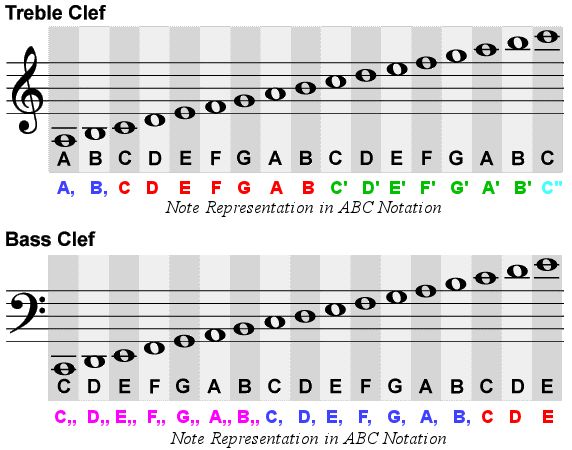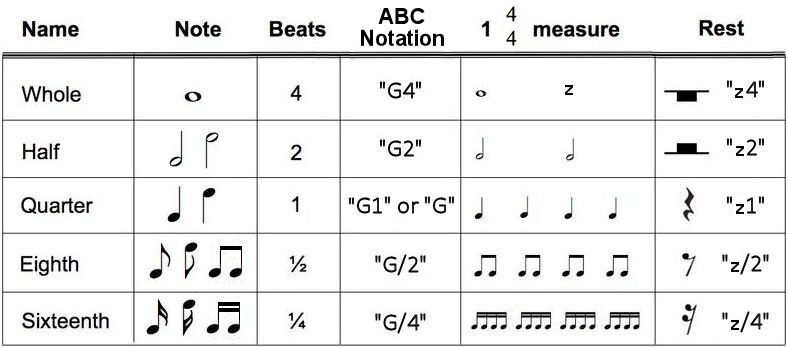Pencil Code and ABC Notation Cheat Sheet
Pencil Code URL: http://pencilcode.net
ABC Notation Site: http://www.abcnotation.com
Notes on the Treble Clef and Bass Clef Staves and Their Representation in ABC Notation
adapted from: http://www.guitarsite.de/pics/clef.gif
Explanation
- the notes in octave #4, from middle C to B, are represented as capital letters:
C D E F G A B - to represent notes in the next higher octave (#5), put an apostrophe (
') after the letter:C' D' E' F' G' A' B'- to represent the octave above that, use two apostrophes, etc.:
C'' D'' E'' ...
- to represent the octave above that, use two apostrophes, etc.:
- to represent notes in the next lower octave (#3), put a comma (
,) after the letter:C, D, E, F, G, A, B,- likewise, to represent the octave below that, use two commas, etc.:
C,, D,, E,, ...
- likewise, to represent the octave below that, use two commas, etc.:
- to represent rests, use the letter Z, but note that some software “engines” require a lowercase z
Representating Note and Rest Durations in ABC Notation
adapted from: http://musictutorial.in/wp/wp-content/uploads/rest.jpg
For dotted notes, which have half again the duration value of the non-dotted note, use a fraction
- for example,
E'3/4in the third measure in the following example
Example
Setting the Key Signature, Time Signature, and Tempo in ABC Notation
- these are set code letters forllowed by a colon (
:) - key signature: K:C K:Eb K:F# K:Gmaj K:Emin
- time signature (meter): M:4/4 M:3/4 M:5/4
- the first number is the number of beats per measure
- the second number identifies the note that gets 1 beat, which is typically a quarter note, hence the number 4
- tempo (beats per minute): Q:60 Q:120
Representing Sharps, Flats, and Naturals in ABC Notation
- to sharpen a note, precede it with a carat (^)
- to flatten a note, precede it with an underscore (_)
- to naturalize a note, precede it with an equals sign (=)
Example
Additional ABC Notation Symbols
Two other symbols are used in the sample program linked at the top of this page and in the examples above
- the vertical bar (
|) is a musical bar line- a bar line simply separates the music into measures according to the time signature
- each measure is a segment of time corresponding to a specific number of beats [https://en.wikipedia.org/wiki/Bar_(music)]
- for simplicity, our examples all call the sing function with the notes for only one measure unless a “tie” (see below) is required to connect notes in different measures
- the hyphen (
–) can be either a musical “tie” or “slur,” both of which are drawn as curved lines connecting two notes as you can see in the above examples- if the curved line connects two notes of the same pitch, it is a “tie”
- this notation indicates that the two notes are to be played as a single note, with a duration equal to the sum of the individual notes’ values [https://en.wikipedia.org/wiki/Tie_(music)]
- this notation is often used if the two notes to be connected are separated by a bar line (
|)
- if the curved line connects two notes of different pitches, is is a “slur”
- this notation indicates that the two notes are to be played without separation [https://en.wikipedia.org/wiki/Slur_(music)]
- if the curved line connects two notes of the same pitch, it is a “tie”




